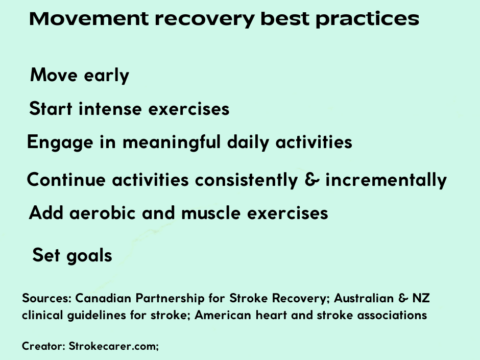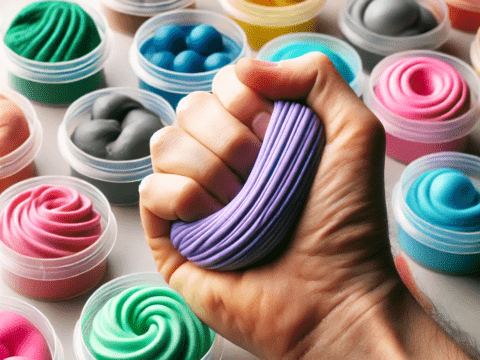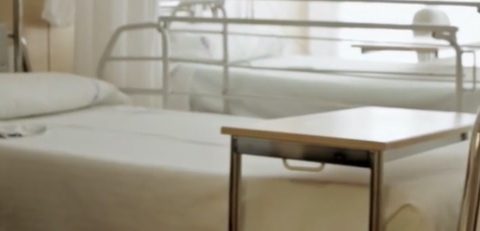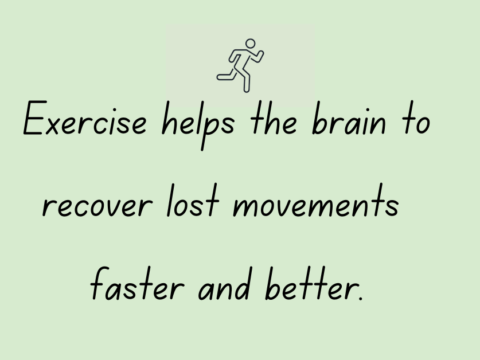
Last updated on September 2024
First read the basics: Basics to regain movements after a stroke.
Below is the summary of the basics;
- Start early,
- Adhere to an intense program,
- Do activities that are meaningful, engaging, and tasks-specific,
- Be consistent,
- Include muscle-strengthening exercises,
- Include aerobic exercises,
- Set goals.
Things we must know in your journey to regain arm movements
- Encourage the use of the weakened arm
- What exercises?
- How much and how long?
- How do we ensure continuity?
- What are the other supportive activities?
Which side?: The affected arm or both arms?
The guideline recommends paying more attention to the affected arm.
Give priority to the weaker arm and hand if only one side is affected – Promote the use of the weaker arm and hand more and more, than both arms; this is what the latest research reveals.
“Promote use of the weaker arm and hand more and more”
2019 Canadian Stroke Best Practice Guidelines; 2014 Cochrane Review
The evidence comes from the 2019 Canadian Stroke Best Practice Guidelines1 and the 2014 Cochrane review2.
Q: Why should we promote the use of the affected arm?
A: The affected neurons stop sending electric signals to the affected arm. This arm does not recover its function due to lack of stimulation.
Therefore,
Always encourage using the affected arm and hand. These attempts stimulate the surviving neurons and send electric signals to the brain’s affected side.
As a result, the surviving neurons release a unique protein. Researchers call it the “Brain-Derived Neurotrophic Factor” (BDNF). This protein promotes the growth of new dendrites and synapses3.
Warning!
If we do not promote using the affected body parts, the brain will identify that part as non-functioning.
So,
What exercises?
The exercises should be meaningful, engaging, and task-specific.
What are those?
Think of the following activities;
- Lifting a cup
- Grasping
- Gripping
- Sit-to-stand
- Folding
- Pouring
- Buttoning
- Lifting
- Combing hair

Make those activities challenging and progressively difficult. That means the difficulty of doing these activities should be increased with time.
Experts caution against a common pitfall while carrying out those exercises – the trunk should not be used to compensate during the training sessions.
In addition to these, muscle-strengthening exercises are also necessary. However, these exercises should not be the main goal3.
Choose common activities of daily living for training sessions.
2019 Canadian Stroke Best Practice Guidelines1
How much and how long?
Hundreds of repetitions required.
Researchers are searching for a definite answer to this question. However, based on animal research about 250-300 successful repetitions seem necessary per session4.
How to promote continuity
Virtual reality and video gaming
The success of the re-training sessions depends on continuity. This is very difficult because of fatigue and frustration due to the absence of quick results.
One way to address the challenge is to incorporate gaming practices such as video gaming. Virtual reality is another. Evidence shows these strategies promote engagement3.
The 2015 Cochrane review found beneficial effects of virtual reality and video gaming in improving arm function. The benefit was greatest for those with a low-moderate impairment and within less than six months post-stroke5.
Carers’ role in exercises
Research has shown that one gains better results when stroke caregivers assist in rehab exercises.
However,
a physical therapist’s assistance is ideal for creating personalized stroke arm rehabilitation exercises. They know what post-stroke arm recovery techniques are.
The good news is that the outcome of home-based programs is similar to usual outpatient hospital program6.
Add the following supportive activities too;
Training sessions should include the following supportive activities also.
- Range of motion (ROM) exercises (passive and active-assisted)
- Mental practice or mental imagery
- Functional electrical stimulation for the wrist and forearm muscles
- Constraint-induced movement therapy; is for those who have at least 20 degrees of active wrist extension and 10 degrees of active finger extension, with minimal sensory deficits and normal cognition
- Mirror therapy – this is an adjunct for those with very severe paresis
There is no adequate evidence to support the following methods!
According to a Cochrane review published in 2015, no evidence exists to support the following methods to improve arm function after stroke.
- Music therapy
- Repetitive transcranial magnetic stimulation
- Medications
- Electrical stimulation
And, also read this post as well to find out how the brain fights back in its recovery journey in the event of a stroke attack.
References
- Canadian Stroke Best Practice Guidelines (2019): 5.1. Management of Upper Extremity Following Stroke
- Alex Pollock, Sybil E Farmer, Marian C Brady, Peter Langhorne, Gillian E Mead, Jan Mehrholz, Frederike van Wijck, Cochrane Stroke GroupCochrane Database Syst Rev. 2014 Nov; 2014(11): CD010820. Published online 2014 Nov 12. doi: 10.1002/14651858.CD010820.pub2PMCID: PMC6469541
- AHA/ASA guidelines for Adult stroke Rehabilitation & Recovery June 2016 – Upper Extremity Activity Recommendations
- Cameron S. Mang, Kristin L. Campbell, Colin J.D. Ross, Lara A. Boyd, Promoting Neuroplasticity for Motor Rehabilitation After Stroke: Considering the Effects of Aerobic Exercise and Genetic Variation on Brain-Derived Neurotrophic Factor, Physical Therapy, Volume 93, Issue 12, 1 December 2013, Pages 1707–1716, https://doi.org/10.2522/ptj.20130053
- Stroke Rehabilitation ClinicalHandbook, 2020: Page13 http://www.ebrsr.com/sites/default/files/EBRSR%20Handbook%20Chapter%204_Upper%20Extremity%20Post%20Stroke_ML.pdf
- Laver KE, George S, Thomas S, Deutsch JE, Crotty M. Virtual reality for stroke rehabilitation. Cochrane Database of Systematic Reviews 2015, Issue 2. Art. No.: CD008349. accessed on August 16, 2021.
- Coupar F, Pollock A, Legg LA, Sackley C, van Vliet P. Home-based therapy programs for upper limb functional recovery following stroke. Cochrane Database Syst Rev. 2012;5:CD006755.
Read more…
- Brain’s recovery attempts after stroke
- Six rules to recover movements after a stroke
- Games like card play help improve arm/hand stroke recovery.
- Free tools to recover movements after a stroke



